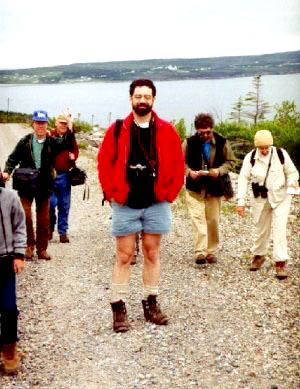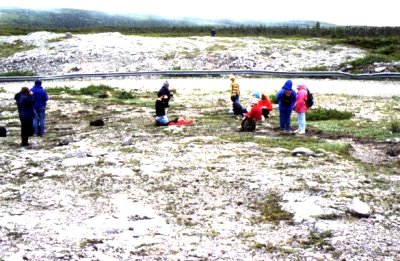Centennial Field Trip – July 1996
A complete account of the NEBC Centennial Field Trip to Newfoundland was not prepared. However, partial account written by Dr. Paul Somers may be provided later to give some flavor of the excursion. Sample images from the trip are offered below. The third through seventh photos were supplied by Dr. Paul Somers. The remainder are by Ray Angelo. Click any image for full size.
In celebration of the New England Botanical Club’s centennial year and to commemorate the outstanding contributions to understanding of the flora of Newfoundland made by one of the Club’s founding members, Merritt L. Fernald, who explored the Canadian island extensively during a series of expeditions dating from 1910 to 1929, a week long botanical trip to Newfoundland was made by 28 individuals (Club members, spouses and friends) in July, 1996. The trip was led by Club members Dr.’s Garrett Crow and Barre Hellquist, who have botanized the island considerably themselves in more recent decades. The Club sponsored trips focused on several sites in the western and northern portions of Newfoundland. Crow and Hellquist led four field trips and provided an overall itinerary with many suggestions of travel and lodging options. Travelers were on their own to make camping or lodging arrangements and participate as they wished in the Club sponsored outings. This made for a fun filled trip enjoyed by all with many different stories to tell. Just getting to Newfoundland was an adventure. Most spent 2-5 days traveling through Maine, New Brunswick and Nova Scotia, enjoying the scenery and sites, and then took a five hour ferry trip from North Sydney, Nova Scotia to Port au Bosques, Newfoundland.

Strolling up Table Mountain near Stephenville, Newfoundland
July 1, 1996
Photo by Ray Angelo

Table Mountain near Stephenville, Newfoundland
July 1, 1996
Photo by Ray Angelo
The first Club outing on July 1 was to Table Mountain, a limestone capped mountain overlooking Port au Port Bay with many interesting calciphiles such as Dryas integrifolia, Saxifraga aizoides, Tofieldia pusilla, Anemone parviflora, Erigeron hyssopifolius, Lesquerella purshii, Asplenium viride, Woodsia glabella, and Cypripedium calceolus var. planipetalum. The latter, a variety of yellow lady-slipper, was at the peak of its bloom and growing in large patches on the barren, scrubby landscape.
The trek to the top was a gradual climb up a gravel road. At the top the group was met by rain, wind and fog, but, undaunted, all continued to explore rocks and crevices for interesting plants. Fossils in the limestone highlighted the trip down the mountain as interests turned from plants to the underlying bedrock of the roadside.
From here the group traveled north to Gros Morne National Park for several days of exploring. Many camped at the Berry Hill campground within the park for several days, while others opted for Bed and Breakfast places in nearby communities like Lobster Cove and Rocky Harbour. The park delighted everyone with opportunities to explore its rugged, beautiful coasts, bogs, and mountains. The second official Club outing was to an area known as the serpentine Tablelands in the southwest portion of the park. Like the limestone Table Mountain, this site presented a rocky barren landscape, but oxidizing serpentine covered the entire mountain giving it a rusty, orange color. Vegetation was limited to scattered or clumped small colonies of herbs and low woody plants amidst an overwhelming mountain of rock.
We hiked up along a stream cascading down a gorge from a glacial cirque with pockets of snow still present around its rim wall. Only plants tolerant of the high magnesium soils and harsh weather of the mountain were seen on this hike. Quite common were dwarf tamarack and juniper amidst patches of sedge and Potentilla fruticosa. Often seen with these plants were colonies of thriving pitcher plants, Sarracenia purpurea. Some of the more unusual species present were Lychnis alpinus and Armeria maritima, both with pink flowers, several other members of the pink family besides Lychnis, such as Arenaria marcescens, Arenaria humifusa, Arenaria rubella, Cerastium arvense and Silene acaulis.
